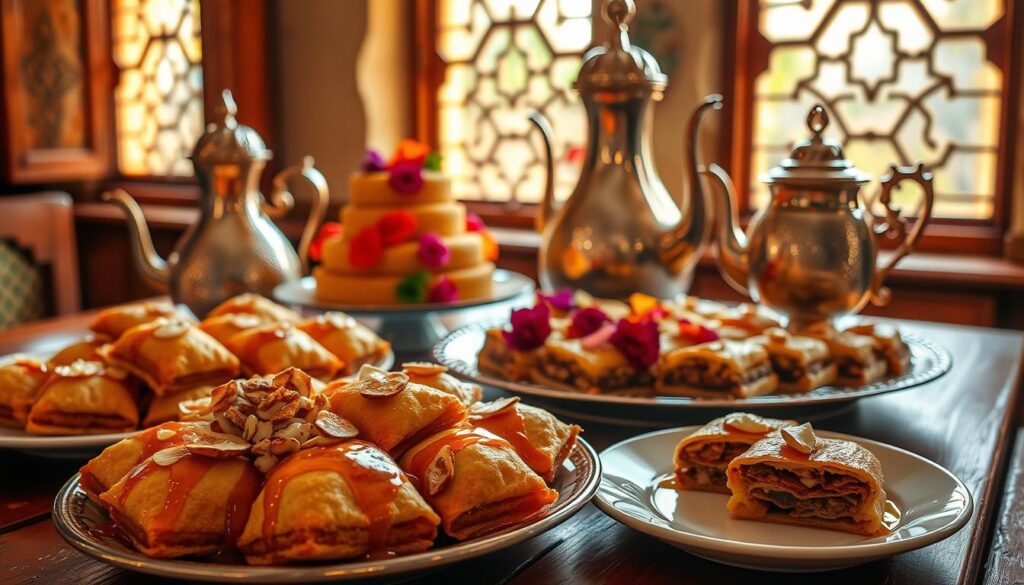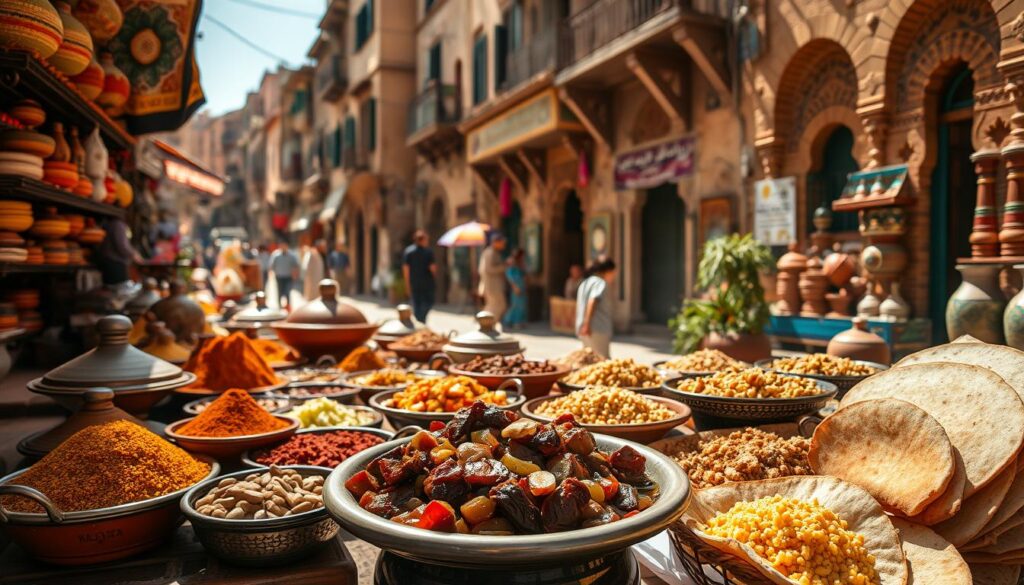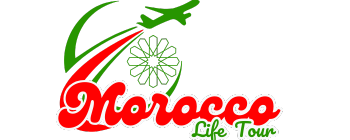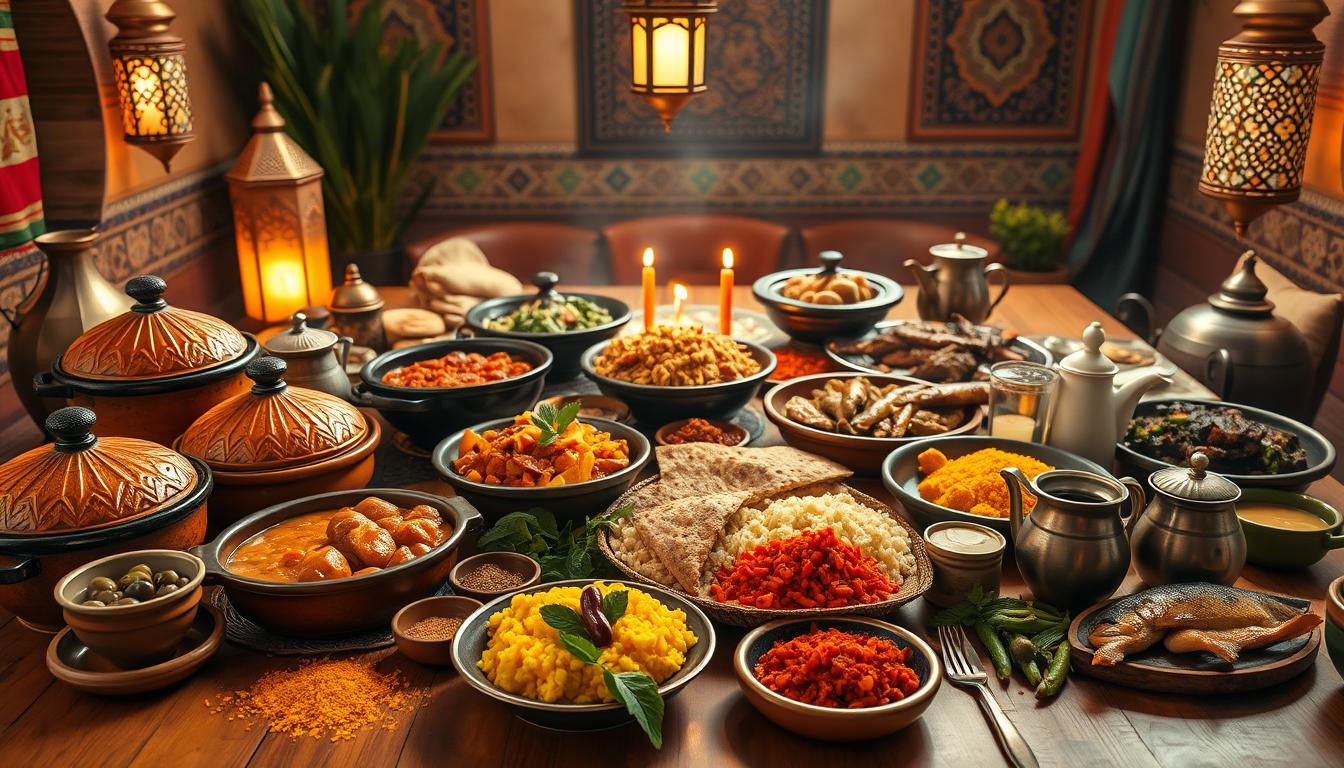What are the must-try foods in Morocco?
Moroccan cuisine is a vibrant tapestry of Moroccan flavors, blending the country’s rich cultural heritage with the exotic spices of North Africa. From the bustling markets of Marrakech to the coastal towns of Essaouira, the diversity of Moroccan cuisine is a culinary journey waiting to be explored.
The allure of Moroccan dishes lies in their complexity and depth, with a harmonious balance of spices, herbs, and other ingredients that create a truly unique gastronomic experience. As we delve into the world of Moroccan flavors, you’ll discover the must-try dishes that make Moroccan cuisine so beloved.
Key Takeaways
- Explore the diverse and rich culinary heritage of Morocco.
- Discover the unique blend of spices and flavors that define Moroccan cuisine.
- Learn about the cultural significance of food in Moroccan culture.
- Find out which Moroccan dishes you shouldn’t miss.
- Understand the influence of North African cuisine on Moroccan cooking.
The Rich Heritage of Moroccan Cuisine
The rich heritage of Moroccan cuisine is a testament to the country’s history as a cultural melting pot. Over centuries, various cultures have influenced the culinary landscape, resulting in a unique gastronomic identity.
Moroccan cuisine is characterized by the blending of Berber, Arab, and Mediterranean influences. The indigenous Berber communities contributed their traditional cooking methods, such as slow cooking and preservation. Arab influences introduced new ingredients and spices, while Mediterranean traders brought their own culinary techniques.
Berber, Arab, and Mediterranean Influences
The Berber influence is evident in the use of local ingredients like barberries, almonds, and olives. Arab cuisine introduced exotic spices such as cumin, coriander, and cinnamon, which are now staples in Moroccan cooking. The Mediterranean impact is seen in the use of ingredients like lemons, capers, and olive oil.
“Moroccan cuisine is a reflection of the country’s cultural diversity, with each region offering its unique flavors and traditions.”
The combination of these influences has resulted in a distinct culinary identity that is both flavorful and aromatic. The use of a wide range of spices, herbs, and ingredients has made Moroccan cuisine renowned worldwide.
The Art of Slow Cooking and Preservation
Slow cooking and preservation are fundamental techniques in Moroccan cuisine. The traditional tagine cooking method, for example, involves slow-cooking meat and vegetables in a clay pot with a conical lid, allowing flavors to meld together.
Preservation techniques, such as salting, pickling, and drying, are used to extend the shelf life of ingredients. Preserved lemons and olives are staples in Moroccan cuisine, adding a burst of flavor to various dishes.
Essential Spices and Ingredients
The unique taste of Moroccan dishes is largely due to the strategic use of key spices and ingredients. Moroccan cuisine is a complex blend of flavors, with each dish carefully crafted using a variety of Moroccan ingredients that contribute to its distinctive taste.
The Magic of Ras el Hanout
Ras el Hanout, which translates to “head of the shop,” is a blend of spices that can include up to 30 different ingredients, such as cinnamon, cumin, coriander, ginger, and turmeric. This complex mix is a cornerstone of Moroccan cooking techniques, used to add depth and warmth to a variety of dishes, from tagines to couscous.
The exact composition of Ras el Hanout can vary significantly from one region to another and even from one household to another, making it a unique and personal aspect of Moroccan cuisine.
Preserved Lemons and Olives
Preserved lemons and olives are staples in Moroccan cuisine, adding a salty, tangy flavor to various dishes. Preserved lemons are made by salting and preserving lemons in their own juice, creating a distinctive flavor that is both sour and umami. Olives, often preserved in a mix of olive oil, lemon juice, and spices, are used to add depth to tagines and salads.
Argan Oil: Morocco’s Liquid Gold
Argan oil, often referred to as “Morocco’s liquid gold,” is a luxurious ingredient extracted from the kernels of the argan tree. Rich in antioxidants and with a distinct nutty flavor, Argan oil is used both in cooking and as a finishing oil for dishes, adding a rich, velvety texture to salads, couscous, and grilled meats.
What Are the Must-Try Foods in Morocco?
When exploring Moroccan cuisine, there are several must-try dishes that showcase the country’s culinary diversity. Moroccan cuisine is known for its rich flavors, aromas, and textures, which are often the result of combining various ingredients and cooking techniques.
Tagine Varieties: Chicken, Lamb, and Vegetable
One of the most iconic Moroccan dishes is the Tagine, named after the earthenware pot in which it is cooked. Tagine can be made with a variety of ingredients, including chicken, lamb, and vegetables, often slow-cooked in a mixture of spices, herbs, and sometimes dried fruits.
Chicken Tagine is a popular version, typically made with chicken pieces cooked in a rich sauce flavored with ginger, garlic, and spices. Lamb Tagine is another favorite, often cooked with dried prunes and almonds, giving it a sweet and savory flavor profile.
| Tagine Type | Main Ingredients | Flavor Profile |
|---|---|---|
| Chicken Tagine | Chicken, ginger, garlic, spices | Savory, slightly spicy |
| Lamb Tagine | Lamb, dried prunes, almonds, spices | Sweet, savory, rich |
| Vegetable Tagine | Mixed vegetables, spices, herbs | Light, aromatic, flavorful |
Couscous: The Friday Tradition
Couscous is a staple in Moroccan cuisine, often served on Fridays. It is made from semolina flour and is typically steamed over a pot of simmering vegetables or meat. The traditional method of preparing couscous is labor-intensive, involving multiple steaming processes to achieve the right texture.
Pastilla: The Celebratory Dish
Pastilla is a savory pie made with layers of flaky pastry, meat, onions, and spices. It is often served at special occasions and is known for its complex flavor profile and intricate preparation method.
Rfissa and Other Lesser-Known Delicacies
Rfissa is a traditional Moroccan dish made with lentils, fava beans, and a type of flatbread called “msemen” or “rfissa bread.” It is often served with a spicy sauce and is considered a comfort food in Moroccan cuisine.
Soups and Stews for Every Season
From the comforting warmth of Harira during Ramadan to the rich flavors of Bissara and Tangia, Moroccan soups and stews are a culinary delight that varies with the seasons and regions.
Moroccan cuisine is known for its hearty soups and stews, which are not only flavorful but also deeply rooted in the country’s culinary traditions. These dishes are often made with locally sourced ingredients and are tailored to the needs of the community, whether it’s a nourishing meal during the cold winter months or a light, refreshing soup for the warmer seasons.
Harira: The Ramadan Essential
Harira is a traditional Moroccan soup that is particularly significant during Ramadan. It’s a hearty and nourishing blend of tomatoes, lentils, chickpeas, and spices, making it a staple for breaking the fast. Harira is not just a meal; it’s a ceremony, often served with dates and other sweet treats to rejuvenate after a day of fasting.
Bissara and Tangia: Regional Favorites
Bissara, a rich and comforting fava bean soup, is a regional favorite in the northern parts of Morocco. It’s often served with a drizzle of olive oil and a sprinkle of cumin, giving it a distinct flavor. Tangia, on the other hand, is a slow-cooked stew made with meat (usually lamb or beef), spices, and sometimes preserved lemons, cooked in a traditional clay pot.
Both Bissara and Tangia showcase the diversity of Moroccan cuisine, with each region having its own version of these dishes. They are often enjoyed during special occasions and are a testament to the country’s rich culinary heritage.
| Dish | Main Ingredients | Region |
|---|---|---|
| Harira | Tomatoes, Lentils, Chickpeas | National |
| Bissara | Fava Beans, Olive Oil, Cumin | Northern Morocco |
| Tangia | Lamb/Beef, Spices, Preserved Lemons | Marrakech |
In conclusion, Moroccan soups and stews are a vital part of the country’s culinary identity, offering a range of flavors and textures that cater to different tastes and occasions. Whether it’s the comforting Harira, the rich Bissara, or the slow-cooked Tangia, each dish is a reflection of Morocco’s rich gastronomic culture.
Delicious Street Foods of Morocco
From savory sandwiches to sweet pastries, Moroccan street food has something for everyone. The vibrant streets of Morocco are a culinary paradise, offering a diverse array of dishes that reflect the country’s rich gastronomic heritage.
Moroccan Sandwiches: Bocadillos and Briouat
Moroccan sandwiches, known as bocadillos, are a staple in the street food scene. These are typically made with crusty bread filled with a variety of ingredients such as grilled meats, vegetables, and cheese. Another popular variant is briouat, a savory pastry filled with meat, onions, and spices, then deep-fried to perfection.
Msemen, Beghrir, and Harcha: Bread Varieties
Morocco’s street food culture is also characterized by its diverse bread offerings. Msemen is a square-shaped pancake made with layers of dough, often served with a mixture of spices, onions, and herbs. Beghrir, on the other hand, are small, crumpet-like pancakes with a porous texture, typically enjoyed with honey or syrup. Harcha, a rough-textured bread, is often served with various toppings or used as a base for sandwiches.
Grilled Meats and Seafood from the Markets
The markets of Morocco are renowned for their grilled meats and seafood. Visitors can find an assortment of skewers, from chicken and lamb to fish and shrimp, all expertly grilled over open flames. These are often seasoned with a blend of spices, including cumin, coriander, and paprika, giving them a distinct flavor.
Moroccan street food is not just about the food; it’s an experience that encompasses the sights, smells, and tastes of the local culture. Whether you’re exploring the bustling markets of Marrakech or the coastal towns of Essaouira, the street food scene is sure to leave a lasting impression.
Sweet Treats and Desserts
Indulge in the sweet world of Moroccan cuisine, where pastries, fruits, and nuts come together in harmony. Moroccan desserts are a reflection of the country’s rich cultural heritage and its history of trade and cultural exchange.
Moroccan Pastries: Kaab el Ghazal and Chebakia
Moroccan pastries are renowned for their intricate designs and delicious flavors. Kaab el Ghazal, also known as “gazelle horns,” are crescent-shaped pastries filled with almond paste, symbolizing the delicate balance between simplicity and elegance. Chebakia, on the other hand, are deep-fried pastry flowers coated in honey and sprinkled with sesame seeds, typically enjoyed during special occasions.
- Kaab el Ghazal: Almond-filled crescent pastries
- Chebakia: Deep-fried pastry flowers in honey
Fresh Fruits, Dates, and Nuts
Morocco’s diverse climate allows for a wide variety of fresh fruits, dates, and nuts, which are often served as desserts or used in traditional sweets. Fresh dates, particularly during the harvest season, are a delicacy, while nuts like almonds and pistachios are commonly used in pastries and desserts.

Halwa, Sellou, and Festival Sweets
Moroccan sweets like Halwa and Sellou are staples during festivals and special occasions. Halwa, a sweet, gelatinous dessert flavored with rose water or orange blossom water, is a favorite. Sellou, a rich dessert made from roasted flour, nuts, and honey, is both nourishing and delicious.
- Halwa: Rose water or orange blossom water-flavored dessert
- Sellou: Roasted flour, nuts, and honey dessert
Traditional Beverages
Traditional Moroccan beverages are an integral component of the country’s hospitality and cultural identity. Drinks play a significant role in Moroccan social life, often serving as a catalyst for social gatherings and communal bonding.
The significance of traditional beverages in Morocco can be seen in their preparation, presentation, and the context in which they are consumed. From the ceremonial pouring of tea to the refreshing taste of freshly squeezed juices, every drink has a story to tell.
Mint Tea: The Ceremony and Tradition
Mint tea, known as “Atay” in Arabic, is more than just a drink in Morocco; it’s a symbol of hospitality and friendship. The preparation of mint tea is an art form, involving the careful selection of green tea, fresh mint leaves, and sugar. The tea is traditionally served in ornate teapots and small glasses, often decorated with intricate designs.
The ceremony of serving mint tea is steeped in tradition. The person serving the tea, usually the head of the household or the most senior person present, pours the tea from a height to create a frothy top, which is considered a sign of good hospitality.
Key elements of the mint tea ceremony include:
- Using high-quality green tea leaves
- Selecting fresh mint leaves for the best flavor
- The ceremonial pouring of the tea
- Serving the tea in decorative glasses
Fresh Fruit Juices, Coffee, and Herb Infusions
Apart from mint tea, Morocco offers a variety of other traditional beverages. Fresh fruit juices made from oranges, pomegranates, and other fruits are popular, especially during the hot summer months.
Moroccan coffee, known for its strong flavor, is another staple in Moroccan cafes. It’s often served in small cups and enjoyed with sweet treats like pastries.
Herb infusions, or “shay bil nana” when made with mint, are also common. Other herbs like verbena and chamomile are used to make soothing drinks that are enjoyed for their flavor and medicinal properties.
In conclusion, traditional Moroccan beverages are a vibrant part of the country’s culture, reflecting its rich heritage and hospitality. Whether it’s the ceremonial serving of mint tea or the enjoyment of fresh fruit juices, these drinks play a significant role in Moroccan social life.
Regional Specialties Across Morocco
Exploring Morocco’s regional specialties is akin to embarking on a gastronomic adventure across different cultures and landscapes. The country’s diverse geography, from the Atlantic coast to the imperial cities and the southern regions, has given rise to a rich tapestry of culinary traditions.

Coastal Delicacies from Essaouira and Agadir
The coastal towns of Essaouira and Agadir are renowned for their fresh seafood. In Essaouira, grilled fish is a staple, often served with a side of chermoula, a herb and spice marinade that adds a burst of flavor. Agadir, on the other hand, is famous for its seafood tagines, where fish and shellfish are cooked in a clay pot with aromatic spices.
A notable dish from the coastal region is fish pastilla, a delicate pastry filled with fish, onions, and spices. This dish exemplifies the blend of traditional Moroccan ingredients with Mediterranean influences.
| Region | Specialty | Description |
|---|---|---|
| Essaouira | Grilled Fish | Fresh fish grilled to perfection, often served with chermoula. |
| Agadir | Seafood Tagine | A flavorful stew of fish and shellfish cooked in a clay pot. |
Fez and Meknes: The Imperial Cuisine
Fez and Meknes, the imperial cities of Morocco, boast a rich culinary heritage. Traditional dishes like trid and pastilla are staples in these cities. Trid, a dish made with layers of thin dough, meat, and broth, is a testament to the sophisticated culinary techniques of the region.
“The cuisine of Fez is a reflection of the city’s historical significance and cultural depth, with dishes that have been refined over centuries.”
Marrakech and Southern Specialties
Marrakech and the southern regions are known for their vibrant markets and hearty dishes. Tagines are a common feature, with variations that include lamb, chicken, and vegetables, all cooked in the iconic clay pots. The south is also famous for its preserved meats, such as kaddid, which is dried and spiced meat, often served with bread or used in stews.
The region’s cuisine is characterized by its bold flavors and spices, reflecting the historical trade routes that passed through Marrakech.
Where to Find Authentic Moroccan Food
To taste the real Morocco, one must venture into the heart of its culinary scene, where local ingredients and traditional cooking methods reign. Authentic Moroccan cuisine is a reflection of the country’s rich cultural heritage and history.
Markets and street food stalls are the lifeblood of Moroccan cuisine, offering a wide array of authentic Moroccan food. From the bustling souks of Marrakech to the coastal towns like Essaouira, these vibrant marketplaces are where locals and visitors alike can sample the country’s culinary delights. Street food stalls, in particular, serve up delicious and affordable dishes that showcase the flavors and ingredients of the region.
Markets and Street Food Stalls
Visiting local markets is an essential experience when exploring Moroccan cuisine. The souks are filled with the aromas of spices, fresh produce, and cooked dishes. Street food stalls offer a variety of traditional snacks and meals, such as grilled meats, freshly squeezed juices, and traditional pastries.
Traditional Restaurants and Riads
For a more formal dining experience, Moroccan restaurants and Riads offer a chance to enjoy traditional cuisine in a more intimate setting. Riads, with their beautiful architecture and tranquil atmospheres, provide a unique dining experience that complements the rich flavors of Moroccan cooking. Many of these establishments are run by locals who take pride in preserving traditional recipes and cooking techniques.
When dining at traditional restaurants or Riads, be sure to try some of the local specialties, such as tagines, couscous, and pastilla. These dishes are often made with love and care, using ingredients sourced from local markets, ensuring an authentic taste of Morocco.
Dining Customs and Etiquette
Moroccan dining customs are a fascinating blend of tradition, hospitality, and community. Mealtimes in Morocco are considered sacred, bringing together family and friends in a spirit of togetherness and generosity.
Dining in Morocco is typically a communal experience, where food is placed in the center of the table, and everyone shares from the same dishes. This communal style of eating is not just about the food; it’s about bonding and strengthening social ties.
Communal Eating and Hand Washing
In Moroccan culture, communal eating is a significant aspect of dining etiquette. It’s customary to eat with your right hand, as the left hand is considered unclean. Before meals, it’s essential to wash your hands, as this is seen as a sign of respect and cleanliness.
When participating in a communal meal, it’s polite to wait for the host to indicate where to sit and when to start eating. The host often takes the first bite, signaling to the others that it’s okay to begin.
Meal Times and Hospitality
Moroccans take great pride in their hospitality, and mealtimes are considered an opportunity to showcase this. Meals are often elaborate and plentiful, reflecting the host’s generosity and respect for their guests.
In Morocco, meal times are generally later than in many Western countries. Lunch is typically served between 1 pm and 3 pm, while dinner can be as late as 8 pm or 9 pm. Guests are often encouraged to linger over their meals, enjoying conversation and company as much as the food.
Understanding and respecting these customs can greatly enhance your dining experience in Morocco, allowing you to fully immerse yourself in the local culture and build meaningful connections with the people you meet.
Conclusion: Embracing the Flavors of Morocco
Moroccan cuisine is a vibrant tapestry woven from the threads of Berber, Arab, and Mediterranean influences. This rich culinary heritage is reflected in its diverse dishes, from the slow-cooked tagines to the sweet pastries and refreshing mint tea. As we conclude our culinary journey through Morocco, it’s clear that the country’s food is not just about sustenance, but an experience that embodies the warmth and hospitality of its people.
A Moroccan cuisine summary wouldn’t be complete without mentioning the essential spices and ingredients that give its dishes such distinct flavors. Ras el Hanout, preserved lemons, and argan oil are just a few of the components that make Moroccan food so unique. Whether you’re looking to recreate a Moroccan food experience at home or plan a trip to Morocco to savor these flavors firsthand, the world of Moroccan cuisine has much to offer.
As you explore the recipes and dishes highlighted in this article, we invite you to immerse yourself in the culinary delights of Morocco. Let the aromas and tastes transport you to the bustling markets and serene riads, and inspire you to bring a piece of Morocco into your own kitchen.
FAQ
What are the essential spices used in Moroccan cooking?
Moroccan cuisine relies heavily on spices like cumin, coriander, cinnamon, ginger, and Ras el Hanout, a blend that can include up to 30 different spices.
What is Tagine and how is it cooked?
Tagine is a slow-cooked stew named after the earthenware pot in which it’s cooked. The pot has a conical lid that allows steam to condense and drop back into the dish, making the meat tender and flavorful.
What is the significance of Couscous in Moroccan cuisine?
Couscous is a staple in Moroccan cuisine, traditionally served on Fridays. It’s made from semolina flour and is often served with vegetables, meat, and sauce.
What is Pastilla, and when is it typically served?
Pastilla is a savory pie made with layers of flaky pastry, meat, onions, and spices. It’s often served at special occasions and celebrations.
How is Argan oil used in Moroccan cooking?
Argan oil, known as “Morocco’s liquid gold,” is used in cooking and as a finishing oil for dishes. It’s rich in antioxidants and has a distinct nutty flavor.
What is Harira, and when is it typically consumed?
Harira is a hearty soup made with tomatoes, lentils, chickpeas, and spices. It’s traditionally eaten during Ramadan to break the fast.
What are some popular street foods in Morocco?
Moroccan street food includes items like Bocadillos (sandwiches), Briouat (fried or baked pastries), Msemen (a type of pancake), and grilled meats and seafood.
What is the cultural significance of mint tea in Morocco?
Mint tea is an integral part of Moroccan culture, symbolizing hospitality. It’s traditionally served to guests as a sign of respect and welcome.
Where can I find authentic Moroccan cuisine?
Authentic Moroccan food can be found in traditional restaurants, Riads, markets, and street food stalls. Visiting local markets and cooking with traditional ingredients can also help in experiencing the real flavors of Morocco.
What are some dining customs I should be aware of in Morocco?
In Morocco, it’s customary to eat with your right hand, as the left hand is considered unclean. Communal eating is also common, and it’s polite to wait for the host to start eating before you begin.


